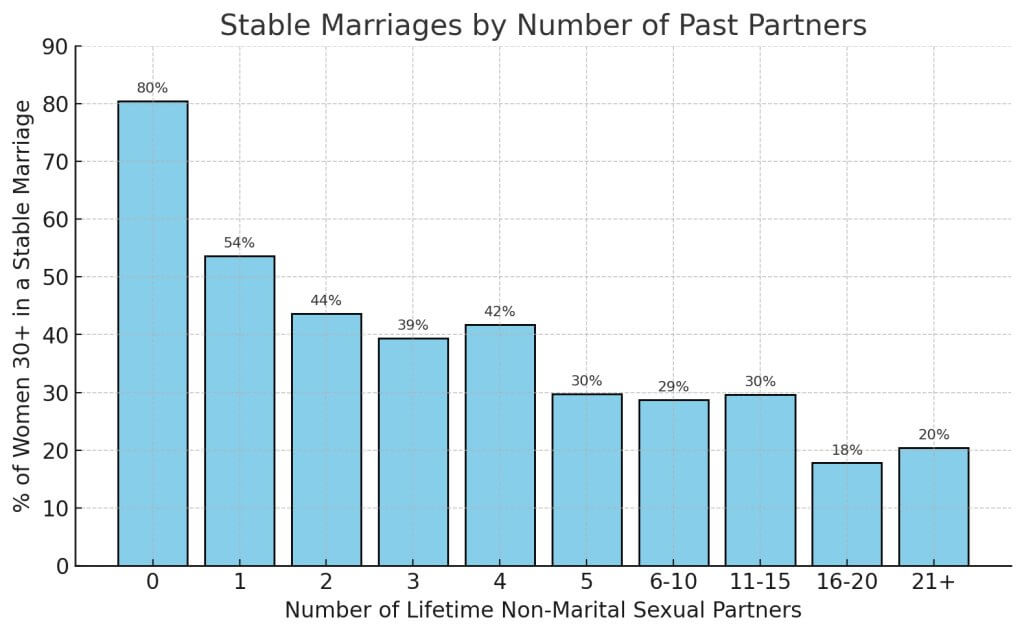
Do a woman’s past sexual experiences affect her ability to form a stable, fulfilling, and committed relationship? This question has been explored in numerous psychological and sociological studies across the world. Some discussions claim that women with higher numbers of past sexual partners struggle to bond long-term: they purportedly report less relationship satisfaction, are more prone to breakups or infidelity, and become “emotionally exhausted” in ways that hinder lasting commitment. In this report, we examine these claims against global data from peer-reviewed research and large-scale surveys. We will see that many studies do find a correlation between a woman’s number of past partners and key relationship outcomes – including relationship satisfaction, emotional attachment, and stability – though the issue is complex and involves both behavioral and biological factors. Below, we review the evidence in structured sections, citing current research and statistics to evaluate each specific claim.
Sexual History and Relationship Satisfaction
Several studies indicate that women with a greater number of past sexual partners tend to report lower satisfaction in their marriages or long-term relationships. In a national U.S. survey analyzed by sociologist Nicholas Wolfinger, women who had only 1 lifetime sexual partner (their spouse) were the most likely to report being “very happy” in marriage . In contrast, women who had multiple premarital partners were less likely to rate their marriages as very happy. Notably, Wolfinger found the lowest odds of marital happiness (about 13 percentage points lower than the one-partner group) among women with 6–10 lifetime partners . This suggests that once a woman’s sexual history reaches the high single digits, her likelihood of enjoying a very satisfying marriage drops significantly.
These findings are echoed by earlier research. Psychologists Galena Rhoades and Scott Stanley reported that women with multiple premarital sexual partners tended to have lower overall relationship quality (satisfaction, stability, etc.) once married, whereas women who only slept with their eventual spouse had the highest-quality marriages . (Interestingly, Rhoades and Stanley did not find a similar strong effect for men; a man’s marital quality wasn’t as tightly linked to his sexual history .) They theorized one reason for women’s lower satisfaction could be comparison and “awareness of alternatives” – i.e. women with more past experiences have more basis for comparing a current partner, which can breed discontent. In fact, regions with more single people (more alternatives) tend to have higher divorce rates, supporting the idea that being aware of other options can undermine contentment .
Survey data quantifies the satisfaction gap. In one large American survey, about 65% of women with 1 lifetime partner described their marriage as “very happy,” versus only ~52% of women with 6–10 partners . Another analysis found that women with 4 or more past partners had significantly lower odds of being very happy in their relationship compared to those with only 2 partners . In short, having a handful or more ex-partners is correlated with a modest but real “happiness penalty” in long-term relationships. Researchers caution that this doesn’t doom anyone to unhappiness, but statistically women with multiple past partners are a bit more likely to experience dissatisfaction or lower emotional fulfillment with their current partner . Possible reasons include comparisons to previous partners, difficulties in fully trusting or valuing one partner, or other factors we explore below.
Infidelity Risk and Emotional Attachment
A high number of past partners is also associated with traits and behaviors that can destabilize relationships – namely, a greater propensity for infidelity and weaker attachment or commitment tendencies. In psychology, the concept of “sociosexuality” is used to describe a person’s comfort with casual, uncommitted sex. Unsurprisingly, someone who has had many casual partners typically has an “unrestricted” sociosexual orientation, meaning they enjoy sex outside of committed relationships and do not see sex and emotional attachment as necessarily linked . Crucially, sociosexuality is a fairly stable personal trait – in other words, a person who was promiscuous in the past often retains a higher inclination toward uncommitted or multiple partners in the future. This has direct implications for long-term fidelity. As one research review bluntly noted: “One of the strongest predictors of marital infidelity is one’s number of prior sex partners.” In fact, past behavior is such a good predictor of future cheating that having many previous partners consistently ranks as a top risk factor for extramarital affairs in studies .
Empirical findings back this up. A 2005 study in Personal and Social Psychology Bulletin reported that the number of prior sexual partners was one of the strongest predictors of later infidelity . Likewise, a 2007 national survey of American women found that the probability of a woman engaging in extramarital sex increased with her number of lifetime sexual partners . Women who had more sexual relationships in the past were significantly more likely to have “secondary partners” (affairs) during marriage . A twin study in the UK even found a genetic correlation: the same genetic factors that incline a woman toward having many sex partners also make her more prone to infidelity . Not surprisingly, women who had been unfaithful in that study had double the number of past sexual partners, on average, as women who remained faithful (7.7 vs 3.8 partners) .
In practical terms, this means a woman with an extensive sexual history is statistically more likely to struggle with sexual exclusivity once in a long-term relationship. The mindset and habits developed through serial casual relationships can carry into marriage. By contrast, a woman with little or no prior experience tends to have a more “restricted” sociosexuality, placing high value on exclusivity and thus is less inclined to cheat . Of course, every individual is different, but large-scale data show a clear link between multiple past partners and higher infidelity risk, which in turn can severely erode relationship trust and stability.
Beyond outright cheating, having numerous past partners can reflect (or result in) a certain approach to relationships that is less conducive to long-term bonding. Relationship scientists note that people high in uncommitted sexual experience often enter marriages less satisfied and remain less satisfied over time, partly because they keep an eye on other options and have lower commitment . In a study of 204 newlywed couples (USA), those individuals with a more “unrestricted” sexual history started their marriages with lower satisfaction and experienced steeper declines in marital happiness over the first few years – and these declines in satisfaction strongly predicted divorce . “When people couple up, they (and their partners) enter into relationships with their own personal relationship histories – if those histories include a cast of previous ‘no-strings-attached’ sexual partners and/or acceptance toward casual sex, then staying in a satisfying, long-term relationship may be more difficult,” explains Juliana French, lead author of that study . In essence, a pattern of past flings can translate into restless or less devoted behavior in a committed partnership, even without overt infidelity. This might manifest as a partner being emotionally volatile, quicker to feel dissatisfied, or always wondering if “someone better” is out there – all of which can undermine the emotional security of a relationship.
Relationship Stability and Divorce Rates
Perhaps the most striking data is on relationship dissolution: numerous studies have found that women with more premarital sexual partners face higher odds of their long-term relationships ending (whether through breakups or divorce). This pattern has been documented for decades. As far back as 1938, psychologist Lewis Terman observed that premarital sexual experience was linked to marital instability . Modern data, with larger samples and controls, consistently reinforce this link. A 2018 study published in the Journal of Family Issues (using U.S. National Longitudinal data) concluded: “Premarital sex raises the chances of divorce between twofold and threefold.” Even after controlling for factors like religiosity, family background, and personality, people who had sex with anyone besides their eventual spouse were 151% more likely to divorce than people who married as virgins . In that study, having even “normative” numbers of partners (1–8) increased divorce odds by about 50% relative to virgins . And those with very high numbers were at even greater risk – having 9 or more premarital partners was associated with significantly higher divorce rates than having fewer partners . Importantly, this study found no gender difference: the effect of multiple premarital partners on marital instability applied to women and men alike .
That said, most analyses have focused on women’s data, and the findings for women are telling. Figure 1 below illustrates the general trend using data from the U.S. National Survey of Family Growth (NSFG). It shows the percentage of women (age 30+) in stable marriages (defined as a first marriage lasting 5+ years) by number of lifetime non-marital sexual partners . The decline in marital stability with more partners is dramatic:

Figure 1: Percentage of women (age 30+) in a stable marriage (≥5 years) by number of premarital sexual partners . Women with few or no prior partners have the highest marital stability, while those with many past partners have a far lower chance of maintaining a long-term marriage.
As shown above, over 80% of women with 0 premarital partners (virgins who married their first sexual partner) were in a stable marriage by age 30+, whereas for women with 5 past partners this figure drops to around 30%, and for those with 16–20 partners it sinks below 20% . In other words, having a high number of past partners is strongly linked to a greater probability of marriage breakdown.
Other studies using different datasets find compatible results. Wolfinger’s analysis of women married in the 2000s (from NSFG data) found that about 33% of women with 10+ premarital partners divorced within the first 5 years of marriage, compared to only 18% of women with 0–1 partners who divorced in that time . Women with 2 partners had an intermediate ~30% divorce rate at 5 years (notably, having exactly 2 partners sometimes appears nearly as risky as very high numbers) . Meanwhile, those with 3–9 partners fell in between, with divorce rates in the 20–25% range in some cohorts . The clear outlier group was women with double-digit body counts: they consistently showed the highest divorce probabilities . It appears that beyond a certain point (around 5–10+ partners), each additional sexual partner adds “baggage” or risk that makes a stable marriage markedly less likely .
It’s important to note that these statistics are correlations – they do not prove that past promiscuity directly causes breakups or divorce. Underlying characteristics could be at play. For example, someone who has many partners might have personality traits (e.g. high impulsivity or low conscientiousness) that also impede long-term commitment. Indeed, researchers find that controlling for factors like race, family background, and religion only explains a portion of the correlation . Still, even after accounting for many such factors, a significant association remains, suggesting that there is something about multiple sexual partnerships itself (or closely related behaviors) that undermines marital stability . As the Institute for Family Studies summarizes, it is now a well-replicated finding that “people with more premarital sex partners have higher divorce rates, broadly speaking” .
On a practical level, this means that women with extensive sexual histories are statistically more likely to experience relationship dissolution. They may cycle through more relationships, and marriages to such women (if they occur) have elevated odds of ending in separation. From a global perspective, this trend has been observed primarily in Western countries (where such surveys are common), but the fundamental dynamic – less prior attachment experiences correlating with greater marital stability – is likely rooted in human relationship behavior that could extend across cultures (with adjustments for local norms). A large 2019 study, for instance, found that this link persisted in contemporary cohorts even as overall attitudes toward premarital sex liberalized . In summary, the greater the number of past sexual partners, the higher the likelihood of a breakup or divorce – especially once the partner count goes well above the average. This directly supports the claim that “exposure to multiple romantic partners leads to a higher likelihood of relationship dissolution.”
This directly supports the claim that “exposure to multiple romantic partners leads to a higher likelihood of relationship dissolution.”
Psychological and Neurological Factors (“Pair Bonding” Effects)
Why might a history of numerous short-term relationships make it harder to maintain one long-term relationship? Researchers have proposed several psychological and neurobiological mechanisms that could explain this pattern. One theory is that the brain and emotional system can become conditioned by repeated casual intimacy in ways that hinder deep pair-bonding. Anthropologist Helen Fisher argues that “casual sex doesn’t really exist” in the sense that our brains are wired to bond during sex – but if someone constantly breaks off relationships and moves to the next, they may be training their brain to treat relationships as temporary . Over time, they become used to exiting when the initial passion fades. Fisher suggests that a woman who has many partners one after another effectively rewires herself to expect short-term flings. Then, “when you try to settle down long-term with your subsequent partner, you are more likely to have difficulties trying to adjust and compromise,” Fisher says . In other words, the patience and effort required in a long relationship may be lacking because her brain has learned that moving on is easier than working through problems. This idea mirrors the transcript’s claim that women with many exes get “used to short cycles of euphoria” and then bail when things calm down – a notion that Fisher’s perspective supports on a neuroscientific level.
If someone constantly breaks off relationships and moves to the next, they may be training their brain to treat relationships as temporary
A woman who has many partners one after another effectively rewires herself to expect short-term flings. Her brain has learned that moving on is easier than working through problems.
Biochemically, oxytocin and vasopressin are hormones known to facilitate bonding and attachment, especially in women (oxytocin is released during sexual intimacy and orgasm, promoting feelings of trust and bonding). Some research suggests that repeatedly forming and breaking sexual bonds might desensitize these bonding mechanisms. The Medical Institute for Sexual Health, for example, reports that casual sex can lead to decreased oxytocin production over time and interfere with the ability to form new pair bonds . In a review, they conclude: “Repeated sexual encounters with multiple partners neutralize the brain. When an individual chooses to engage in casual sex, breaking bond after bond with each new partner, the brain forms a new synaptic map of one-night stands. This pattern becomes the ‘new normal’ for the individual…making a permanent bond more difficult to achieve.” . In plainer terms, each casual relationship might leave a “neurological imprint” – and if those imprints pile up, the brain’s ability to fully attach to a new partner could be diminished. The concept of “oxytocin resistance” was mentioned in the transcript, and while human research is still emerging, this notion parallels how prairie vole studies show that bonding is a specific neurochemical process: once a vole bonds with a mate, its brain receptors change to make new bonds harder, and conversely a vole that mates with many partners without bonding never experiences the receptor changes that facilitate deep attachment . By analogy, a woman who never allows a lasting bond to form (because relationships are repeatedly cut short) might not engage the full oxytocin–dopamine bonding pathway with any partner, or her brain might suppress it, having learned that “sex doesn’t equal lasting attachment.” Neuroscientist Dr. Larry Young explains that while oxytocin plays a role in bonding, “oxytocin alone does not create the bond…there are brain mechanisms that can inhibit bonding after sex with another individual” . If someone habitually treats sex as non-bonding, those inhibitory mechanisms may dominate, making it easier to walk away unhurt – but also harder to truly connect .
From an emotional perspective, frequent breakups can lead to a form of relational burnout or cynicism. Each failed relationship might make it a bit easier for a person to detach the next time. A woman with many exes eventually sees “fights and breakups not as tragedy, but as routine…she’s emotionally worn out”. Clinical research supports a kernel of this: a study on past relationship “solidarity” found that people who had very strong attachments to previous partners actually showed lower commitment and satisfaction in their current relationship . One interpretation is that giving a lot of oneself in past relationships (and being hurt or let down) can leave fewer “emotional reserves” to invest in a new partner . Emotional exhaustion is a real phenomenon – someone who’s been through many romantic ups and downs may build defensive walls or simply not put in the same level of affection, having “seen it all before.” The transcript described this as “loss of exclusivity – you’re just the next one in line.”
A woman with many exes eventually sees “fights and breakups not as tragedy, but as routine…she’s emotionally worn out”
Psychologically, that captures what can happen if a person no longer views any relationship as truly special or unique. They might subconsciously hold back, expecting eventual failure. In extreme cases, a “syndrome of endless choice” can develop, wherein a woman always keeps an eye out for a better option and remains chronically dissatisfied with what she has . This aligns with Rhoades & Stanley’s speculation that having multiple past partners increases awareness of alternatives, which can undermine commitment to the present partner .
There are also mental health correlations that might mediate these outcomes. Some studies find that people (of any gender) who engage heavily in casual sex report higher rates of depression, anxiety, and loneliness compared to those in committed relationships . While cause and effect are hard to untangle (unhappiness can lead to casual sex or vice versa), someone who has had a lot of transient liaisons might carry emotional scars or a jaded outlook that hampers a new relationship. Feeling “burned” by past partners can lead to trust issues, jealousy, or fear of commitment – all of which obviously make a stable, happy relationship harder to sustain. The bottom line is that multiple sexual partners can create a feedback loop of psychological conditioning: sex becomes separated from love, relationships become less emotionally significant, and ending a relationship becomes easier (or even the default solution to conflicts) . This doesn’t mean a person cannot form a lasting bond after many flings, but it may require unlearning those patterns. As one psychologist wrote, “the brain mapping will have to be overcome” if such an individual later desires a permanent partner .
Feeling “burned” by past partners can lead to trust issues, jealousy, or fear of commitment – all of which obviously make a stable, happy relationship harder to sustain. It may require unlearning those patterns. As one psychologist wrote, “the brain mapping will have to be overcome” if such an individual later desires a permanent partner .
Conclusion
Research from around the world largely supports the claims that a high number of past sexual partners can negatively affect a woman’s capacity to form and maintain a stable, satisfying, monogamous relationship. Summarizing the evidence:
• Lower Relationship Satisfaction: Women with more than a few past partners (especially 5 or more) are statistically less likely to report being very happy with their current relationship . Multiple studies show a modest drop in marital satisfaction as partner count rises, with one-partner brides topping the happiness charts and women with numerous ex-partners often feeling less fulfilled or secure with their spouse . This can manifest as greater frustration, “emotional volatility,” or sense of discontent in the relationship, as described in the transcript.
• Higher Infidelity and Commitment Issues: A large body of literature finds that the more sexual partners someone has had, the greater their risk of infidelity in marriage . Women who’ve had many partners are likely to have a more casual view of sex and may struggle with long-term exclusivity, sometimes dubbed an inability to “pair bond.” They also often carry a mindset of keeping options open, which can impede fully committing to one person .
• Emotional Conditioning and Exhaustion: Repeated short-term relationships can condition the brain and emotions to avoid deep attachment. We see indications of diminished oxytocin bonding responses with multiple partners and anecdotal evidence of “relationship fatigue” – women feeling emotionally used up or unable to give each new partner the same devotion as the first few. Each prior breakup potentially toughens a person’s “exit reflex,” making them more inclined to leave when challenges arise rather than work through problems . Over time, this reduces the sense of exclusivity and specialness in any one relationship, which was exactly the warning given in the transcript.
• Greater Likelihood of Breakup/Divorce: Statistically, women with many past partners have higher breakup and divorce rates. Whether we look at U.S. surveys (as in Figure 1 and other cited studies) or other Western data, the trend is consistent: those with the most partners have the least stable unions . For example, marrying as a virgin gives a far lower divorce risk than marrying after several premarital partners, and the risk rises further if she had very many partners . These findings back the claim that multiple romances often lead to an impaired ability to form a lasting pair bond.
It must be emphasized that these are population-level trends and probabilities. Not every woman with a busy sexual past will struggle in love, and having few or zero exes is no guarantee of marital bliss. Individual outcomes vary based on personality, relationship skills, and partner compatibility. There are certainly women with many former partners who learn from those experiences and build very happy marriages – just as there are women with minimal experience who end up unhappy. However, when looking at large samples, the direction of the correlation is clear. As one report succinctly concluded, “the more partners a woman has had, the less likely she is to stay satisfied and married to one” . This does not appear to be mere coincidence; even after accounting for confounding factors, the link remains .
In summary, accumulating many sexual partners can indeed make it harder for a woman to form a stable, emotionally committed union, for both psychological and possibly physiological reasons. Such women are a bit more prone to dissatisfaction, more likely to engage in infidelity or comparison-thinking, and less likely to stay in a long relationship without it dissolving. Believes that after “five or more” partners a woman loses her sense of exclusivity and struggles to bond – are supported in spirit by the data, albeit with some nuance (the exact “threshold” number may not be rigid, and men are not entirely immune to these effects either). Ultimately, these findings highlight the profound ways in which our past experiences shape our relationship behaviors. While one should be careful not to stigmatize individuals based solely on “body count,” the science does indicate that past promiscuity can carry forward into present relationship challenges . For those seeking lasting, high-quality relationships, this research suggests that minimizing casual entanglements and focusing on intentional, meaningful partnerships may indeed increase the odds of long-term success . Each person’s journey is unique, but as the data shows, our actions and habits in romance can have lasting consequences on our capacity to love and bond for the long haul.
Sources: Peer-reviewed studies and surveys (General Social Survey, NSFG, etc.) as cited above; Institute for Family Studies analyses ; Psychological Science (French et al. 2019) ; Journal of Family Issues (2023) ; statements by experts (Helen Fisher, Larry Young) ; and other scholarly and media sources as referenced.














Complètement faux, cela dépend juste de trouver le bon partenaire, et parfois il faut plusieurs expériences pour réussir à trouver le bon. Cela n’a rien avoir avec le facteur d’infidélité.
Excelente este editorial, no menciona la relacion de la parte economica , y mas cuando la mujer gana buenos ingresos y si ideologia es que le lleguen hombres de menores ingresos o formacion profesional, para generar dependencia de ellos hacia ella.
To the user “Granier”.
They are STUDIES. Your premise may be real for men, but NOT WOMEN. This is biology.